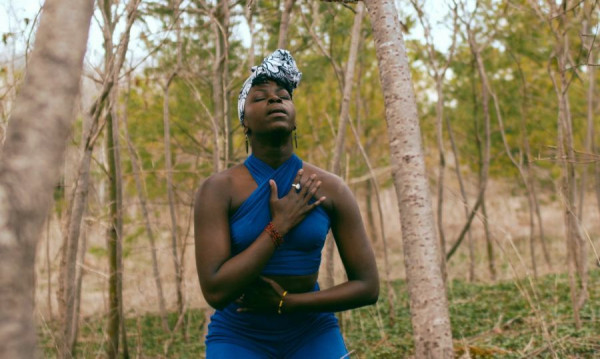Award-winning as much for her skills as an artist, as for her community leadership, Mensah tackles issues she encounters head-on and channels them into her work, resulting in beautifully powerful performance experiences. Such as her latest work, Shades.
This strikingly beautiful work is powerfully exploring discrimination between lighter- and darker-skinned people within our community. Carved from real-life experiences by Esie and her cast of ground-breaking collaborators, the highly athletic full-length work features Esie alongside her ensemble of six outstanding artists as they recount moments of discrimination, pain and healing.
In an exclusive essay for ByBlacks.com, Esie describes where her inspiration for Shades comes from.

PHOTO BY: Erica Cheah
Shades is a project that is bigger than me, which is why I kept coming back to it. The inception of Shades was a slow build. Tiny voices that kept speaking to me time and time again until I had to listen it. Rooted in the barriers of my own career, I needed to address what prevented me from being as successful as I wanted to be about 6 years ago.
My journey into creating Shades wasn’t one sparked from a major event. I experienced shadeism at the same level of most people. I was made fun of because I was dark and because my skin had varying tones. This prevented me from truly falling in love with my skin at a young age. I never wanted to alter it but I did wish that it looked different. My relationship to my skin grew over time once it evened out. I could finally fall in love with my complexion and not feel like I was lacking something. The journey of Shades opened up the pandora’s box in my life and I began to take a closer look at the pain I’ve held onto for years. I never expected one show to transform me so much but it did.

PHOTO BY: Erica Cheah
I was recently reflecting with a friend about my time doing the film Rocky Horror Picture Show in 2016. The audition held the best of the best in the city and I wowed the client. Dancing in front of Kenny Ortega and Lou Adler after not auditioning for years felt amazing. Once the audition was done, I spoke with Jasmyn Fyffe as we both considered our fates knowing we did well, but were unsure how many of us (black women) would be chosen. The way the industry is set up, we believe there is only room for one of us…maybe two if we are lucky. In the end there was A LOT of melanin in that film (Jasmyn and myself both booked it) but the film was unconventional so it called for it. I began to question why there is only room for a few and as a dark skinned woman I tend to believe that most rooms won’t include my shade.
The biases I built against myself are rooted in the barriers I experienced in my own career. I became complacent in justifying that I wasn’t enough for certain opportunities. I knew I was talented but I couldn’t get work. I would see other dancers who were less talented, working a lot more than me (many of them were Caucasian). This reality was a hard pill to swallow but all of these experiences helped inform my work in the future.
Feeling the lack of opportunity because of my shade was a regular occurrence at that stage in my career but it started in my teenage years. If I were to look back on my life, my experiences with men; wanting to be noticed and feeling forgotten or overlooked was a constant thing. When these things happen, I question my shade. Is there something wrong with me? Am I not desirable enough that they wouldn’t choose me? If I were lighter, would this still happen? Sometimes my answers aren’t pretty but they are definitely honest.

PHOTO BY: Erica Cheah
Once I started researching this topic during my time away in the Caribbean in the summer of 2016, I realized how many people dealt with this issue. I’ve had to dig deep with this work and explore all aspects. The information I gathered in the black community and other communities of colour, made me realize that the issue of shadeism is buried. It’s a blind acceptance that helps to keep up its facade. And all of this is happening in silence. Trying to bring that silence forward was a blessing and a curse. I did not know what to do and how to put it together as too many questions flooded the surface.
My biggest challenge was, how do you put this into movement on stage with dancers and not make it look overdone. I constantly felt l like a student in the process of creating this work. I can never say I 100% knew what it would turn out to be. All I knew was that I wanted to get to a space of healing with the work and we achieved that. As communities of colour, I feel we don't talk enough and this piece will spark a needed conversation.

 By
By 





![[REVIEW] Ain’t Too Proud — The Life and Times of the Temptations Will Leave You Singing Motown Classics For Days](/media/k2/items/cache/4b41d8402a855349daa868762863cbe9_S.jpg?t=20181122_175321)

